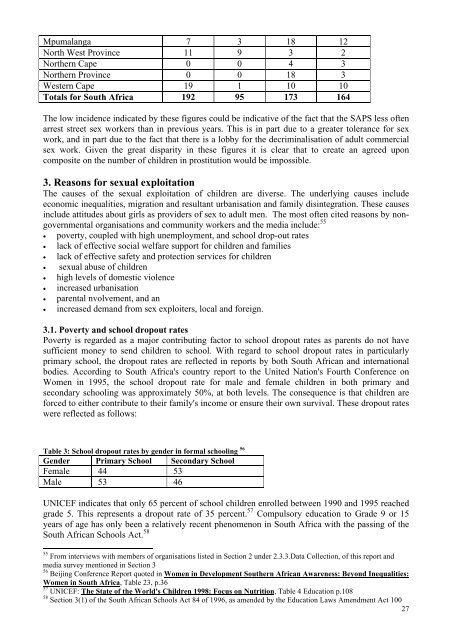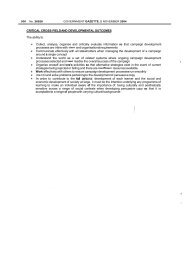The trafficking of children for purposes of sexual exploitation
The trafficking of children for purposes of sexual exploitation
The trafficking of children for purposes of sexual exploitation
You also want an ePaper? Increase the reach of your titles
YUMPU automatically turns print PDFs into web optimized ePapers that Google loves.
Mpumalanga 7 3 18 12<br />
North West Province 11 9 3 2<br />
Northern Cape 0 0 4 3<br />
Northern Province 0 0 18 3<br />
Western Cape 19 1 10 10<br />
Totals <strong>for</strong> South Africa 192 95 173 164<br />
<strong>The</strong> low incidence indicated by these figures could be indicative <strong>of</strong> the fact that the SAPS less <strong>of</strong>ten<br />
arrest street sex workers than in previous years. This is in part due to a greater tolerance <strong>for</strong> sex<br />
work, and in part due to the fact that there is a lobby <strong>for</strong> the decriminalisation <strong>of</strong> adult commercial<br />
sex work. Given the great disparity in these figures it is clear that to create an agreed upon<br />
composite on the number <strong>of</strong> <strong>children</strong> in prostitution would be impossible.<br />
3. Reasons <strong>for</strong> <strong>sexual</strong> <strong>exploitation</strong><br />
<strong>The</strong> causes <strong>of</strong> the <strong>sexual</strong> <strong>exploitation</strong> <strong>of</strong> <strong>children</strong> are diverse. <strong>The</strong> underlying causes include<br />
economic inequalities, migration and resultant urbanisation and family disintegration. <strong>The</strong>se causes<br />
include attitudes about girls as providers <strong>of</strong> sex to adult men. <strong>The</strong> most <strong>of</strong>ten cited reasons by nongovernmental<br />
organisations and community workers and the media include: 55<br />
• poverty, coupled with high unemployment, and school drop-out rates<br />
• lack <strong>of</strong> effective social welfare support <strong>for</strong> <strong>children</strong> and families<br />
• lack <strong>of</strong> effective safety and protection services <strong>for</strong> <strong>children</strong><br />
• <strong>sexual</strong> abuse <strong>of</strong> <strong>children</strong><br />
• high levels <strong>of</strong> domestic violence<br />
• increased urbanisation<br />
• parental nvolvement, and an<br />
• increased demand from sex exploiters, local and <strong>for</strong>eign.<br />
3.1. Poverty and school dropout rates<br />
Poverty is regarded as a major contributing factor to school dropout rates as parents do not have<br />
sufficient money to send <strong>children</strong> to school. With regard to school dropout rates in particularly<br />
primary school, the dropout rates are reflected in reports by both South African and international<br />
bodies. According to South Africa's country report to the United Nation's Fourth Conference on<br />
Women in 1995, the school dropout rate <strong>for</strong> male and female <strong>children</strong> in both primary and<br />
secondary schooling was approximately 50%, at both levels. <strong>The</strong> consequence is that <strong>children</strong> are<br />
<strong>for</strong>ced to either contribute to their family's income or ensure their own survival. <strong>The</strong>se dropout rates<br />
were reflected as follows:<br />
Table 3: School dropout rates by gender in <strong>for</strong>mal schooling 56<br />
Gender Primary School Secondary School<br />
Female 44 53<br />
Male 53 46<br />
UNICEF indicates that only 65 percent <strong>of</strong> school <strong>children</strong> enrolled between 1990 and 1995 reached<br />
grade 5. This represents a dropout rate <strong>of</strong> 35 percent. 57 Compulsory education to Grade 9 or 15<br />
years <strong>of</strong> age has only been a relatively recent phenomenon in South Africa with the passing <strong>of</strong> the<br />
South African Schools Act. 58<br />
55 From interviews with members <strong>of</strong> organisations listed in Section 2 under 2.3.3.Data Collection, <strong>of</strong> this report and<br />
media survey mentioned in Section 3<br />
56 Beijing Conference Report quoted in Women in Development Southern African Awareness: Beyond Inequalities:<br />
Women in South Africa, Table 23, p.36<br />
57 UNICEF: <strong>The</strong> State <strong>of</strong> the World's Children 1998: Focus on Nutrition, Table 4 Education p.108<br />
58 Section 3(1) <strong>of</strong> the South African Schools Act 84 <strong>of</strong> 1996, as amended by the Education Laws Amendment Act 100<br />
27
















